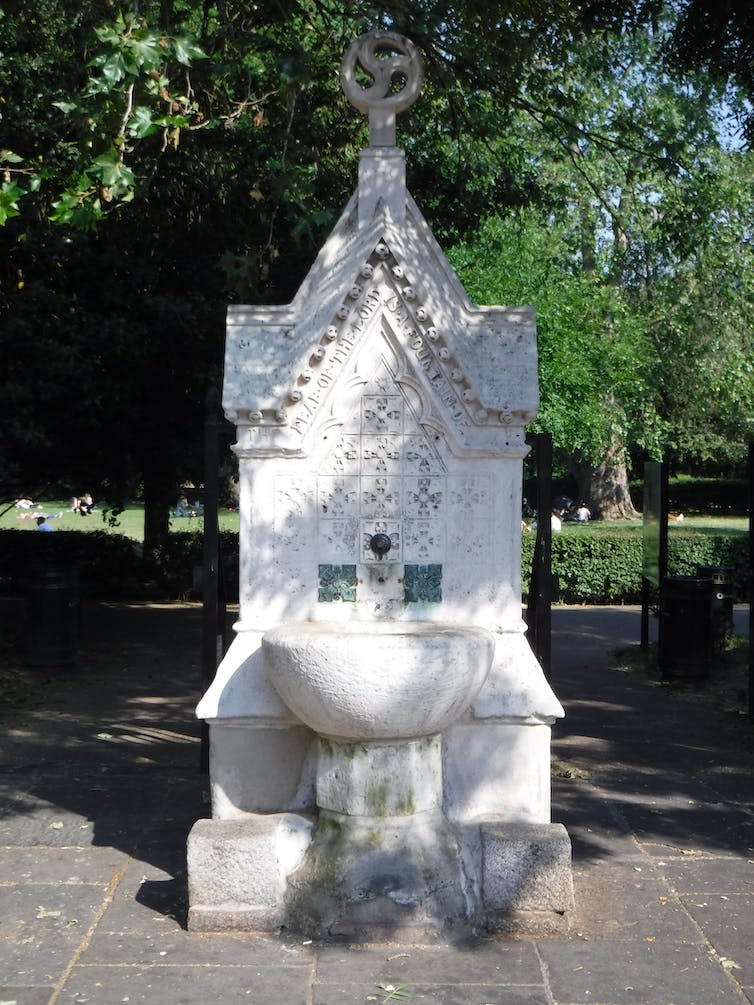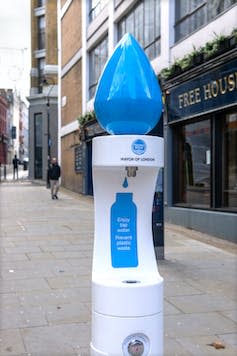The curious history of London's public drinking water fountains

Drinking fountains are a common sight in London today, but they’re a relatively recent addition to the city. Until the mid-19th century, Londoners quenched their thirst by supping beer in pubs rather than guzzling water on the streets. As temperatures heat up, it’s a good time to review the history and politics that lie behind a cooling swig of drinking fountain water in the UK’s capital city.
Our ongoing archival research, part of a project on London’s water history and politics, explores the movement that inspired the construction of public drinking fountains at a remarkable rate in the late 19th century.
Some 40 years after the first fountain was opened in Holborn in 1859, over 500 had been installed across the city. They supplied free drinking water to the masses, and reinvigorated London’s public spaces.
The rapid expansion of water fountains was connected to the limits of London’s privatised water network. Echoing criticism of water companies today, the private firms that supplied London’s drinking water in the 19th century prioritised profits over investment in infrastructure. As a result, the quality and coverage of water services suffered.
From the 1850s, pioneering medical research linked cholera epidemics to polluted water and demonstrated the public health risks of London’s water network.
The expansion of drinking water fountains was one response to these mounting concerns about London’s unequal and, as the cholera research showed, sometimes dangerous water supply. The fountains made it easier to access clean drinking water in the city, especially for the working classes, who often lacked reliable and safe water at home.
The thousands of homeless men, women and children who lived in desperate conditions on London’s streets also benefited.
Quenching London’s thirst
The Metropolitan Free Drinking Fountains Association was established in 1859 to erect and manage London’s new fountains. Samuel Gurney, a banker and politician, was the driving force behind the association and channelled significant sums of his own money into it. He was joined by a motley crew of politicians, doctors, lawyers and engineers, who helped run and promote the association in the late 19th century.
Funding for individual fountains came from various sources, including wealthy benefactors, local governments and multiple contributions from local residents.
Designs varied but one common, if not universal, feature was the name of the person who provided the bulk of the funding and some form of Biblical messaging. Building fountains thus became a popular way for philanthropists to gain social prestige while also showing religious piety.
The inclusion of religious scriptures and symbols indicates the moralising and evangelising mission of many members of the drinking fountain movement. If pubs were a corrupting force, drinking fountains were a way of purifying the souls of the working class.
The association also catered for animals by including dog troughs in fountains and building standalone structures for horses and cattle. In 1867, the association changed its name to the Metropolitan Drinking Fountain and Cattle Trough Association to reflect its wider remit.
While drinking fountains expanded rapidly in the late 19th century, London was slow off the mark and lagged behind several other UK cities, including Aberdeen, Derby and Chester.
Edward Thomas Wakefield, a barrister and founding member of the association, singled out Liverpool for special attention. In his 1859 essay “A Plea for Free Drinking Fountains in the Metropolis”, he noted that on one “fine hot day” in June 1855, a single fountain was used more than 3,000 times in Liverpool.
Once installed, London’s fountains proved to be even more popular, especially on hot summer days. Take one example: on July 4 and 5 1865, the association recorded 5,603 drinkers using the Royal Exchange fountain. There were more than 500 per hour during the early afternoon, and a steady flow throughout the day and night.
Drinking fountains clearly provided ample opportunities for Londoners to engage in one of their favourite pastimes – queuing.
Nevertheless, drinking fountains were not universally welcomed, perhaps because of their moralising tendencies. The association noted in its 1874 annual report that the structures were “peculiarly exposed to thoughtless or malicious injury”, and security staff were at times employed to prevent theft and vandalism.

Public water, private interests
If the public drinking fountain movement shows what is possible when people mobilise around water, it also points to the limits of philanthropic organisations; limits that became more pronounced at end of the 19th century.
The association lost much of its radical zeal, became more conservative in orientation, and struggled financially as donations dried up. The construction of new fountains slowed and the maintenance of existing fountains deteriorated.

It was not until private water companies were brought under public control in the early 20th century that London’s water crisis began to ease, indicating the need for decisive public interventions alongside more piecemeal social initiatives.
Victorian drinking fountains continue to adorn London’s streets and several have been restored to their former glory. Alongside them, a new generation of drinking fountains have emerged, many of which have been designed to reduce the use of plastic bottles.
Rather than including the names of wealthy benefactors and religious inscriptions, these fountains are often emblazoned with the name and logo of the private water company that helped fund them. Once again, we see how providing public water can also serve private interests.
This article is republished from The Conversation under a Creative Commons license. Read the original article.

The authors do not work for, consult, own shares in or receive funding from any company or organisation that would benefit from this article, and have disclosed no relevant affiliations beyond their academic appointment.

 Yahoo News
Yahoo News 
